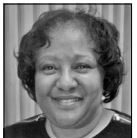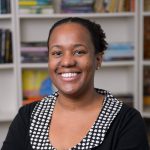We know our classrooms should be rich with diverse books, but we may need explanations to share with colleagues about why we choose a diverse book over an old standard and, perhaps, recommendations on which books to select and a few ideas for how we might use those texts in our classrooms. NCTE, its members, and friends offer the following.
Author Tytianna N. M. Wells Smith says, “Books must mirror the lives of readers…many students related to the stories as they reflected on their lived experiences that connect their home and school identities.”
Author and Illustrator Duncan Tonatiuh notes, “The United States is such a diverse country, and we need diverse books to reflect the different cultural experiences that children have…we need multicultural books so that different kinds of children can see themselves reflected in the books they read, and so that children can learn about people from diverse backgrounds and cultures.”

Violet Harris says, “inclusive diversity matters.” And I use the term “inclusive” because I don’t want to push some groups to the forefront and push other groups to the back.”
Ezra Hyland notes, “When you have children in school and the literature doesn’t look like them, it doesn’t sound like them, it does not deal with their issues, you’re pushing them out rather than inviting them in…We need diverse books because diverse books reflect the world as it is, not the way the world never was and the way the world never will be….Literature and language are life, you know.” Amiri Baraka, I heard him say one time – he was quoting someone else, paraphrasing someone else – that human beings don’t make up stories, but it’s our stories that make us human. And so literature is the repository of our stories and the repository of our humanity, a reminder of our humanity.”
“When you have children in school and the literature doesn’t look like them, it doesn’t sound like them, it does not deal with their issues, you’re pushing them out rather than inviting them in…We need diverse books because diverse books reflect the world as it is, not the way the world never was and the way the world never will be….Literature and language are life, you know.” Amiri Baraka, I heard him say one time – he was quoting someone else, paraphrasing someone else – that human beings don’t make up stories, but it’s our stories that make us human. And so literature is the repository of our stories and the repository of our humanity, a reminder of our humanity.”
 Robert Needlman, a pediatrician in Cleveland, Ohio and cofounder of Reach Out and Read, talked about his approach to primary care, which puts literacy front and center by having literacy-rich waiting rooms and demonstrating to parents how to read to their children. He pointed out new evidence that literacy acquisition and listening to stories changes the structure of the human brain, contributes to the brain’s health, strengthens a child’s attachment to his or her parents, and increases overall emotional health and resilience. His concern, however, is the lack of diversity in the books he collects for his patients, who are predominantly African American.
Robert Needlman, a pediatrician in Cleveland, Ohio and cofounder of Reach Out and Read, talked about his approach to primary care, which puts literacy front and center by having literacy-rich waiting rooms and demonstrating to parents how to read to their children. He pointed out new evidence that literacy acquisition and listening to stories changes the structure of the human brain, contributes to the brain’s health, strengthens a child’s attachment to his or her parents, and increases overall emotional health and resilience. His concern, however, is the lack of diversity in the books he collects for his patients, who are predominantly African American.

Ellen Oh, author and CEO of We Need Diverse Books, stresses the importance of diverse literature for children of color.

Sybil E Durand writes, “To resist “the danger of the single story,” as Chimamanda Adichie discusses in her 2009 TED talk, we need books that tell many different kinds of stories about a particular cultural community.”

“Those of us from minority backgrounds,” note Christina V. Cedillo, “often fail to see ourselves in our school texts, let alone have opportunities to engage with the kinds of knowledge that meaningful representation makes possible. By that we mean representation that transcends mere depiction to encourage meaningful engagement with and reflection on diverse experiences and ways of knowing. As educators we must provide students with texts that reflect their respective backgrounds and engage the perspectives they bring to the classroom.
 … Coauthor Kimberly S. Covert adds, “In fostering students’ appreciation for the unique worldviews and practices integral to their home cultures, teachers can show respect for students’ “home places” and recognize their own positionality as members of cross-cultural communities (Royster, 1996). They can also advance rhetorical awareness that makes transcultural repositioning possible. Transcultural repositioning involves being able to “move back and forth with ease and comfort between and among different languages and dialects, different social classes, different cultural and artistic forms” in order to “open the door to different ways of seeing and thinking about the increasingly fluid and hybridized world that is emerging all around us” (Guerra, 2004, p. 8). Inviting Ethnic Studies into the classroom helps educators foster respectful learning environments while promoting vital communication skills.”
… Coauthor Kimberly S. Covert adds, “In fostering students’ appreciation for the unique worldviews and practices integral to their home cultures, teachers can show respect for students’ “home places” and recognize their own positionality as members of cross-cultural communities (Royster, 1996). They can also advance rhetorical awareness that makes transcultural repositioning possible. Transcultural repositioning involves being able to “move back and forth with ease and comfort between and among different languages and dialects, different social classes, different cultural and artistic forms” in order to “open the door to different ways of seeing and thinking about the increasingly fluid and hybridized world that is emerging all around us” (Guerra, 2004, p. 8). Inviting Ethnic Studies into the classroom helps educators foster respectful learning environments while promoting vital communication skills.”
“I didn’t always know all of the places that I was from until I encountered them in books. I think that we can and should be intentional about including diverse lit as a matter of course whenever we discuss lit in different genres, styles, and so forth.” Olugbemisola Rhuday-Perkovich writes.
Latrise Johnson points out, “ In the predominantly Black high school where I am Professor in Residence and sponsor of the writing club, ELA teachers continue to teach books from the canon like To Kill a Mockingbird, The Scarlet Letter, The Great Gatsby, and Of Mice and Men. And although they are great stories, they do very little when it comes to inspiring the lives of youth of color. Nor do these texts reflect the lived experiences of the students who attend the school. My issue with teaching these texts is not necessarily that they are culturally irrelevant for our students. In fact, I do not propose teaching texts just because they are diverse. Instead, as teachers and teacher educators, our selection of diverse texts must be intentional and must play a role in eradicating racial and social injustice and inequality…Teachers must choose texts with the students in mind.”
points out, “ In the predominantly Black high school where I am Professor in Residence and sponsor of the writing club, ELA teachers continue to teach books from the canon like To Kill a Mockingbird, The Scarlet Letter, The Great Gatsby, and Of Mice and Men. And although they are great stories, they do very little when it comes to inspiring the lives of youth of color. Nor do these texts reflect the lived experiences of the students who attend the school. My issue with teaching these texts is not necessarily that they are culturally irrelevant for our students. In fact, I do not propose teaching texts just because they are diverse. Instead, as teachers and teacher educators, our selection of diverse texts must be intentional and must play a role in eradicating racial and social injustice and inequality…Teachers must choose texts with the students in mind.”
 Mollie Blackburn points out, “I am one among many who have called for bringing LGBTQ-themed literature into English language arts classrooms and queering literature already there. By queering I mean interrogating the notion of normal, particularly relative to sexual identities and gender expressions, but also related to broader notions like family and friendships. Oftentimes these two suggestions get pulled apart, as if teachers can or even should do one or the other, but I think they go hand-in-hand.”
Mollie Blackburn points out, “I am one among many who have called for bringing LGBTQ-themed literature into English language arts classrooms and queering literature already there. By queering I mean interrogating the notion of normal, particularly relative to sexual identities and gender expressions, but also related to broader notions like family and friendships. Oftentimes these two suggestions get pulled apart, as if teachers can or even should do one or the other, but I think they go hand-in-hand.”

Bring your students a little “bookjoy,” as Pat Mora calls it, not only on El día de los niños/El día de los libros but all year long.




